In cinemas today, A Single Man has already generated awards buzz thanks to Colin Firth’s Oscar-nommed, career-best performance .
Well, duh. It’s awards season. You can’t move in the multiplex without hitting someone who’s hoping their name’s in the envelope come March 7th.
Yet, great though his performance is, it’s not Firth who distinguishes A Single Man but the man behind the camera. The film is the directorial debut of fashion designer Tom Ford, the man who put the juice into Gucci and brought sexy back into fashion.
A multi – and we mean multi – millionaire, his move into moviemaking would suggest he’s biggest vanity-project chancer around. Unless, of course, he’s the real deal.
From haute couture to Hollywood contender, we ask: who is Tom Ford?
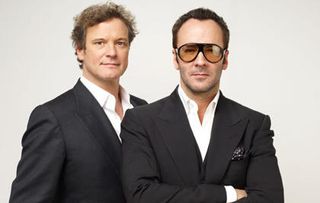
The Hoochie Gucci Man
“I was born in a jacket,” claimed Tom Ford in 1996, explaining how he’d managed to transform the fortunes of faded fashion house Gucci in just two years.
He’s probably fibbing, but it’s a typical Tom Ford line – snappily quotable, dryly funny, pitched somewhere between wry self-deprecation and outstanding arrogance. This is the man, after all, who said, "I think of myself as a product."
If it's actual facts yer after, here goes. Born in Texas to a family of estate agents, Ford achieved his first success acting in commercials as a teenager. That led to the high life of Studio 54’s heyday, where Ford realised that a) he was gay and b) fashion was his calling.
Rising swiftly in the U.S. clothing community, by 1990 he took a calculated decision to go Continental, claiming that American culture was “inhibiting me. Too much style in America is tacky...Europeans, however, appreciate style.”
He got his first gig at Gucci but arrived at a faltering label that was unsure how to react to the twin perils of recession and AIDS, which had sucked both the money and the fun out of fashion.
And then, in 1994, just 32 years old, he got his shot at glory when he was promoted to Creative Director.
Within a year, sales had increased 90%...and when Madonna was papp-snapped wearing Ford-designed Gucci at the 1995 MTV Music Video Awards, the label went stratospheric.
The secret of Ford’s success: sex! Gucci reclaimed its lust(re) because, as Ford noted, "There was a certain hedonistic quality . . . we hadn't had hedonism in so long."
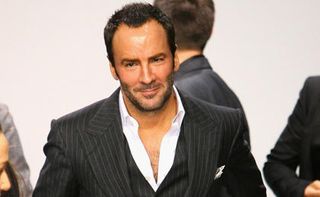
Ford thrived on controversy, establishing Gucci’s naughty credentials with provocative ads like a naked model revealing a G-shaped thatch of pubic hair. Oo er, Carry On up the catwalk.
Ford, cannily, cried wolf. “There had to be a message. When I shaved the G in the girl's pubic hair, that was a comment on the ridiculous lengths we'd gone to with branding." Or, possibly, as the Scissor Sisters put it, he was just being filthy/gorgeous.
Yet column inches alone don’t account for success; Ford was a natural designer ("I'm lucky, I have mass-market tastes. When I say I like a shoe, generally thousands of people will like it") and a hands-on businessman.
By 2000, when Gucci bought Yves St Laurent and Ford found himself helming two of the most prestigious brands in the world. And then – disaster.
A change in management in 2004 signalled a head-to-head, and Ford walked. He left Gucci as one of the world’s most famous and desired brands, and with a personal reputation as the best in the business. What would Tom Ford next?
It's doubtful many anticipated that the answer would be "filmmaking."
Next: Flirting With Film [page-break]
Flirting With Film
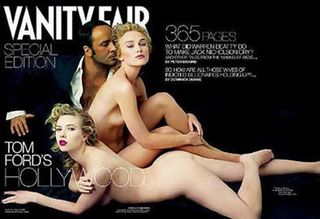
“It was like a divorce. I was bereft,” Ford said of parting with his home of 14 years...
...So when he announced his intention to move into filmmaking, many viewed it with scepticism. This is a rebound thing, right? What the hell did Tom Ford know about directing?
Quite a lot, as it happens. After all, as Ford helpfully pointed out, "They are similar in some ways—both are smoke and mirror worlds."
That was no idle comparison. During his Gucci heyday, Ford's collections were often inspired by Hollywood glamour, Ford watching classic movies to capture their timeless ambience.
And he oversaw advertising and store design as well as clothing, keeping control of the brand’s visual aesthetic to an unprecedented degree.
Whether that meant hiring porn stars for a photoshoot – “we paid for them to have sex on set. You don't see it in the shot, but you feel it” – or hiring someone exclusively to tend to the bonsai trees in his flagship store, there’s an exactitude and innovation worthy closer to Kubrick than Chloé.
An astute judge of talent, here was a casting director who could count Stella McCartney and the late Alexander McQueen amongst his protégés. Yet the biggest star was Tom Ford himself, indecently handsome, effortlessly cool and preternaturally aware of his image.
He learned his lesson the hard way, hating his early experiences as an actor. "I did not like having to read a line the way a director told me to when I thought it was stupid," he told The Guardian in 2008. "Or not being able to rewrite the line myself."
No such problems now he was directing his own performance. "My image is a tool," he admitted to The Daily Telegraph recently. "I look at it as ruthlessly as I look at a picture in an ad - that’s wrong, that’s wrong. I realise its selling power and its potential - the brand personified. But it’s not me..."
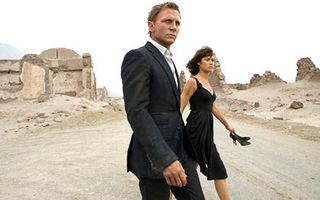
It didn’t hurt that Ford had first hand experience of the A-list; his branded sunglasses are the choice of everyone from Jolie to J-Lo.
Notoreity - and our eternal envy - followed when, guest editing Vogue in 2006, he ended up an inadvertent cover star alongside nekkid Keira Knightley and Scarlet Johansen after the original third model, Rachel McAdams, refused to disrobe.
He appeared on-screen – as himself, natch – in Zoolander , but his biggest credit was as “tailor” on Quantum of Solace , a rather dull way of saying that he provided the suits that sexed up Daniel Craig even when 007 wasn't stripped to his boxers.
"A lot of people think if you wear classic clothes you're dull. Bond dresses that way, but he does not lead a dull life - not sexually and not in his career. And with Daniel, you have someone who looks classic but leads a very exciting life."
Ford was getting closer to his dream. The one thing missing was a project of his own to prove his mettle...
Next: A Single Novel [page-break]
A Single Novel
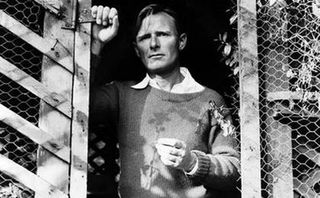
2006: and Ford suddenly has a flashback to a book he’d read as a young man.
A Single Man was written in 1964 by Christopher Isherwood – author of Cabaret' s source novel Goodbye To Berlin and the clear inspiration for the Michael York character in that film.
Depicting a day in the life of George, a gay, middle-aged professor grieving for the death of his lover, the novel's candid study of homosexuality made it a landmark in gay literature.
Certainly, the novel struck a chord with the young Ford, only recently ‘out’ himself. "His loneliness and pain spoke to me," he explained to The L.A. Times last December. "At the time I was single and I fantasized about running into George somewhere and I could help him."
In fact, Ford would later meet Isherwood. In the hedonistic swirl of the early 80s, where Ford counted Andy Warhol amongst his friends, how could he not? “I was fascinated by him but he didn’t notice me really, which I didn’t understand because he was 80 and I was 20 and I was attractive!”
Ford enquired after the rights to the novel...and found they came packaged with a screenplay, written by first time writer David Scearce.
Penned on spec, Scearce had sent his manuscript to Isherwood’s life partner, Don Bachardy, who gave the script his blessing. “He was impressed with it because out of all the adaptations he'd seen, it was the only one that didn't use a voice-over. ... I used flashbacks instead," explains Scearce.

Ever the auteur, Ford set about putting his stamp on the material, rewriting Scearce’s script to make the central character a (Tom) Fordian hero, as he explained to W magazine:
“George, who is very much my own character grafted onto the character, obsessively puts himself together because that is the way he holds himself together.
"His inner world and his outer world are connected, and the only thing holding them together is the polishing of his shoes, the scrubbing of his fingernails, the perfect white shirt. If he let go of that, he would collapse. There is an enormous part of myself that is like that.”
The other major deviation was to make George suicidal, a means of bringing a greater visual drama to the novel’s interior style. Even here, Ford was at pains to get things right, borrowing the details from real life: “the suicide in the story comes from my family. There was a suicide that really took place in my family. It was exactly that re-enacted in the film,” he told WENN.
Gay director takes on gay character drama – too obvious? Despite Ford’s sexual orientation, he was adamant this wasn’t going to be an issue movie.
“We all go through the same things in life—romance, grief, isolation, trying to come to an understanding of what life is about. I wouldn’t want someone not to see it, thinking, Oh, that’s a gay love story. That’s not the core of the film.”
Not Brokeback Mountain , then. Still, he had to find an actor brave enough to bare his soul if not his body. An actor like Colin Firth...
Next: Firth Among Equals [page-break]
Firth Among Equals
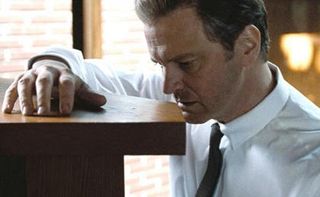
George had already been cast when Ford bumped into Firth at the premiere of Mamma Mia! , and Ford instantly knew he’d missed an opportunity, reportedly exclaiming: “Goddamn it, goddamn it, goddamn it. I need Colin Firth.”
Fate intervened when the actor in place dropped out, and Ford asked Mamma Mia producer Tom Hanks – yes, that Tom Hanks – for Firth’s email. This is what celebrities do.
“He just sent me an email,” Colin Firth recounted to The Daily Telegraph. “And I was struck by the eloquence and sensitivity of what he wrote. Also, the choice of material interested me because it wasn’t what I expected.
"I mean, if one lazily thinks of what a fashion designer might do if he’s going to conquer cinema next, it would be taking the opportunity to display his fashion sensibilities. Choosing the life of a lonely professor in despair in 1962 doesn’t really seem like an opportunity to show your spring collection.”
When Ford followed-up with a face-to-face pitch, Firth signed on - telling W magazine, “If I had any doubts about this fashion designer’s vanity project, they were pretty much gone then. I thought, this just can’t possibly be a banal choice."
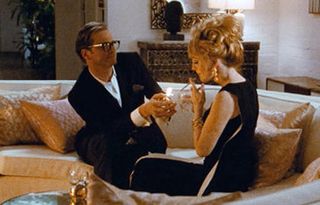
For the role of Charley, the fag-hag friend who holds a torch for George that will never be lit, Ford only had one choice – as Julianne Moore explains.
“I’d run into Tom at the Met ball.” (This is what celebrities do.) “I was like, ‘Hey, Tom, how’s it going with your movie? Are you getting it going?’ And he said, ‘Oh, funny you should mention it.’” Next thing she knew, she was sent a script with her name on it and a part written especially for her.
Rounding out the core human cast were Matthew Goode, seen in flashback as George’s lover, and Skins star Nicholas Hoult as a student who takes a shine to George, in a role once touted for Jamie Bell.
But it’s worth noting the fifth and final member of the ensemble: the film’s exquisite period setting, practically a character in its own right. These days, the go-to guys for anything 1960s is the team behind TV’s Mad Men . Perhaps unsurprisingly, Ford borrowed Dan Bishop and Amy Wells, respectively that show’s Production Designer and Set Decorator.
With cast and crew in place, it was simply a matter of filming – and then funding fell through...
Next: From Catwalks to Cameras... [page-break]
From Catwalks to Cameras...

With investors pulling out when the credit crunch tipped into a stock market freefall, Ford needed a substantial injection of capital right away. What he needed was a fabulously wealthy patron of the arts prepared to put his money where he mouth was. What he needed was...
See where we’re going with this? That’s right, the guy who bailed out the project was Ford himself, the film’s $7 million budget little more than pocket change to such a rich guy.
Still, Ford didn't go down the Avatar route, keeping things lean and mean on a brisk 21-day shoot, maintaining an intimate scale in order to play to his strengths. “I loved every minute, every phase – I’m best when I’m in complete control,” he admitted to W magazine.
Julianne Moore observed to BBC News that, "Tom was very particular about how things looked. Sometimes I've walked on set and the whole production looks wrong, but you felt that he had considered every last little detail about our characters' lives.”
This is, undoubtedly, a film that has the hallmarks of the catwalk. Chris Laverty, editor of costume design blog Clothes on Film , notes “The film is definitely ‘high fashion.’ Slim, sharp mohair suits for men – Italian influence was sweeping men’s fashion in the early sixties. Womenswear was clean, simple and unembellished, almost shapeless.”
Ford, though, isn't convinced anything was out of the ordinary. “Everyone keeps saying to me, 'Everyone is so beautiful. Everything is so beautiful.' I didn't even notice that! That's just the way I see. That's the way I think."
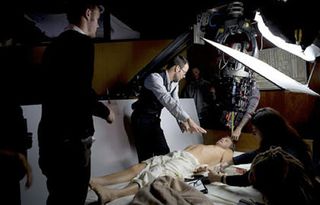
To an extent, he's right: the fashion is but a facade for George’s churning emotions. “Lots of people say: 'Oh a Tom Ford film—that must look great," Colin Firth comments. "But the truth is that the suits I was wearing are like body armour for my character....”
Ford exploited that gap between surface and soul by having different directorial approaches: fastidious on details, but free on characterisation. “The script was quite sparse and it left a lot of space,” said Firth to The Daily Telegraph. “Tom didn’t tell me how to do anything and didn’t bombard us with verbal instructions.
"He gave us a lot of freedom, and I felt I was being given a chance to do things I wasn’t normally given a chance to do. He creates an atmosphere in which people are ready to do their best, and I’m sure he learned that in his years in the fashion business.”
Moore agrees. “At one point I started humming and moving my shoulders. It wasn’t in the script, but it felt right. I would not have been able to do that if Tom was standing over me, telling me what to do.”
As for Ford, was the effort worth it? Absolutely, he told Vogue. "It’s amazing to be in a room full of actors and they move and dress and change according to what I have written for them to do that morning, sitting in my underwear in bed. It puts you in an incredible position of control to be directing the life, death, even the clothing of all these people. And it will last forever.”
The film was in the can, but without a distribution deal. How to sell the film to the industry’s movers and shakers? The only way Tom Ford knew how...
Next: ...And Back To Catwalks [page-break]
...And Back To Catwalks

A Single Man was launched, it has to be said, like a fashion collection. Rather than distributors being sent DVDs, they didn’t get their first sight of the film until the 2009 Venice Film Festival.
The film’s startling blend of style and substance wowed buyers and judges alike; while Firth was busy winning the Festival's Best Actor award, Harvey Weinstein (who else?) picked up the U.S. rights, an eye already on Oscar.
While only a modest success (just over $6 million in America to date) the film is sure to recoup Ford and Weinstein’s investment, and those awards noms keep coming for Firth... Golden Globe, BAFTA and – yes – Oscar.
The film has been well received by critics, too, with the only criticism coming from the gay community, slighted that the suicide subplot weakens George’s status as a pioneering figure in homosexual literature.
Ford’s retort is priceless: “I like chocolate cake. Do I define my life by the fact that I like chocolate cake? For me, that’s what sexuality is. I didn’t think of making a movie with gay characters.”
Judge for yourself: here's the film's trailer.
It’s clear that Ford has beaten his detractors with a powerful, subtle and cinematic debut. According to Firth, "He has put his heart and soul into this. He's told a tale with courage and honesty....
"Yes, people are fascinated because it's Tom Ford, and some people are sceptical because it's Tom Ford, so he's going to have to brave some knives which are out to scalp him—but this film deserves to be judged solely on its merits."
Ford is still buzzing, back where he always belonged – on top and in charge - but what does the future hold? “I have a few more ideas in the pipeline but I’ve only just finished this one so I need to get some distance on it and decide what to do next."
Until then, all eyes are on the BAFTA and Oscar ceremonies to see if Firth’s single man can be paired up with another statuette.
Like This? Then try...
Sign up for our free weekly newsletter here .
Follow us on Twitter here .
